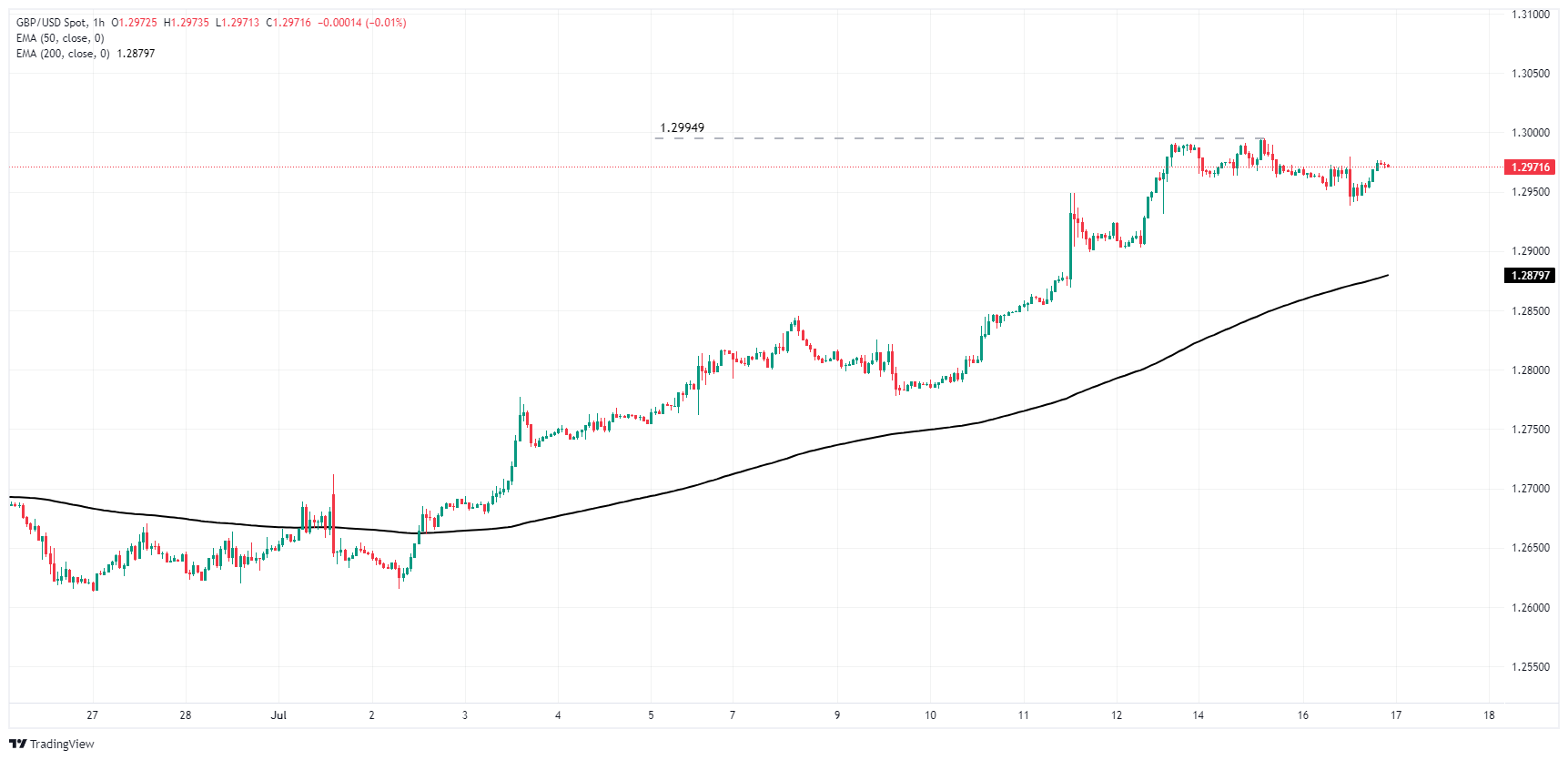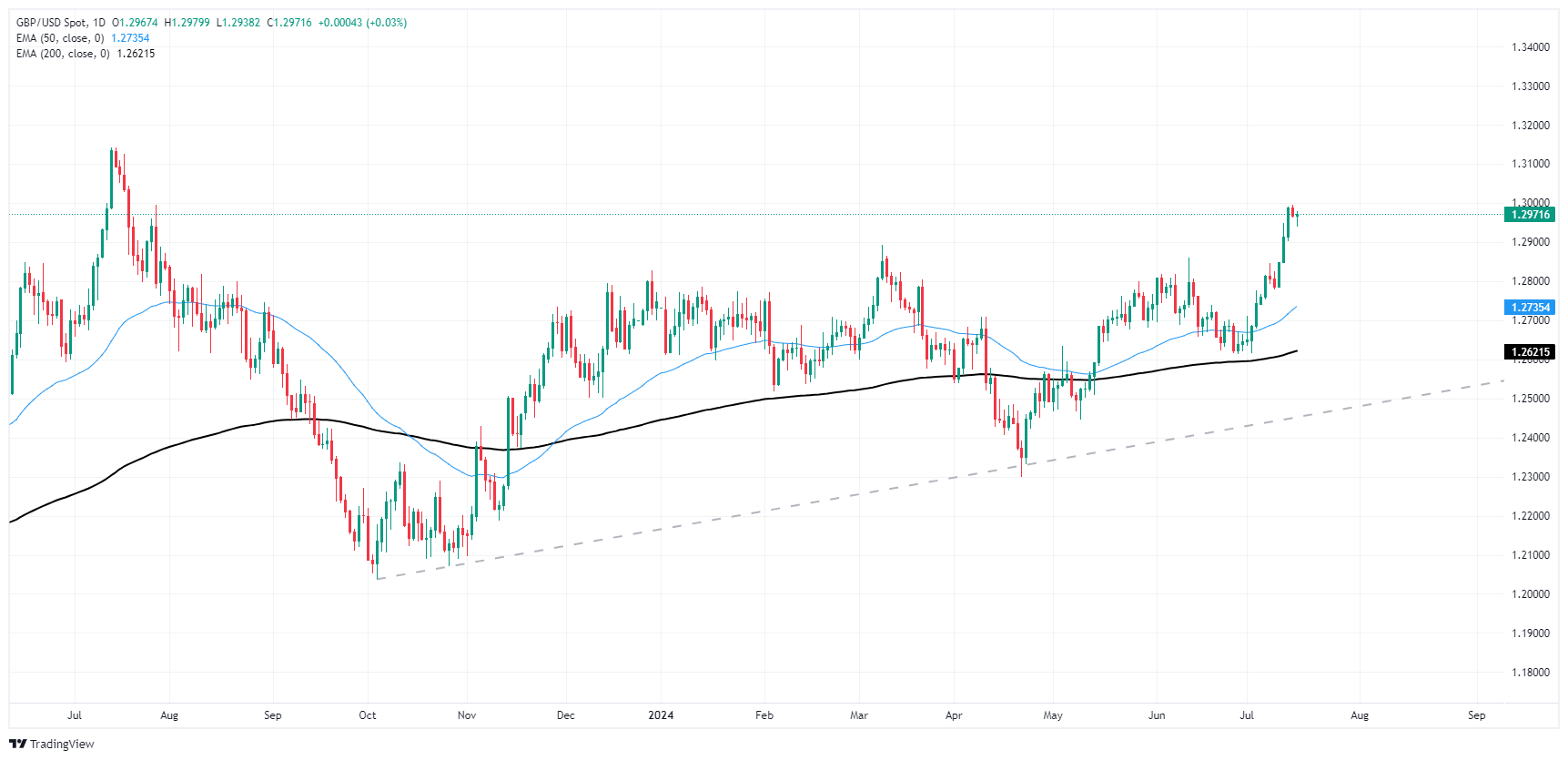GBP/USD churns ahead of key UK CPI inflation data


- GBP/USD cycled familiar territory on Tuesday as markets weigh rate cuts.
- Sterling traders are buckling down for a key print in UK CPI inflation.
- UK labor figures and Retail Sales promise a hectic back half of the trading week.
GBP/USD churned close to recent highs on Tuesday as markets readjusted odds of a rate cut from the Federal Reserve (Fed). A decline in US Retail Sales capped off a recent batch of US data, implying price pressures have finally eased enough that the Fed may get pushed into a rate-cutting cycle in September.
Forex Today: UK, EMU inflation come to the fore along with US data
US Retail Sales slumped to a flat 0.0% in June, matching forecasts and falling from the previous month’s revised 0.3%. Softening US Retail Sales was the final feather in the cap for rate-cut-hungry markets, which piled into bets of a rate cut when the Federal Open Market Committee (FOMC) gathers for its rate call on September 18.
Slumping Retail Sales growth adds on to a batch of Consumer Price Index (CPI) inflation data last week that reignited broad-market hopes for a September rate cut. According to the CME’s FedWatch Tool, rate markets are now pricing in nearly 100% odds of at least a quarter-point rate trim in September, with up to three rate cuts in total for 2024.
GBP traders are rounding the corner into a series of key data releases on the UK side for the latter half of the trading week. Wednesday kicks things off with a fresh print of UK CPI inflation. Near-term UK CPI inflation is expected to tick down to 0.1% MoM in June from the previous 0.3%, while annualized CPI inflation is expected to hold steady at 2.0% YoY.
Thursday continues the UK data parade with updated labor figures. The UK’s Claiming Count Change in June is expected to fall back to 23.4K from the previous print of 50.4K. Friday will follow up with UK Retail Sales for June, which is forecast to decline -0.4% from the previous print of 2.9%.
British Pound PRICE This week
The table below shows the percentage change of British Pound (GBP) against listed major currencies this week. British Pound was the strongest against the New Zealand Dollar.
| USD | EUR | GBP | JPY | CAD | AUD | NZD | CHF |
|---|---|---|---|---|---|---|---|---|
USD |
| 0.08% | 0.12% | 0.14% | 0.20% | 0.77% | 0.97% | -0.06% |
EUR | -0.08% |
| 0.07% | 0.26% | 0.31% | 0.72% | 1.08% | 0.05% |
GBP | -0.12% | -0.07% |
| 0.29% | 0.24% | 0.65% | 0.96% | -0.02% |
JPY | -0.14% | -0.26% | -0.29% |
| 0.05% | 0.40% | 0.78% | -0.39% |
CAD | -0.20% | -0.31% | -0.24% | -0.05% |
| 0.50% | 0.76% | -0.27% |
AUD | -0.77% | -0.72% | -0.65% | -0.40% | -0.50% |
| 0.35% | -0.67% |
NZD | -0.97% | -1.08% | -0.96% | -0.78% | -0.76% | -0.35% |
| -1.03% |
CHF | 0.06% | -0.05% | 0.02% | 0.39% | 0.27% | 0.67% | 1.03% |
|
The heat map shows percentage changes of major currencies against each other. The base currency is picked from the left column, while the quote currency is picked from the top row. For example, if you pick the British Pound from the left column and move along the horizontal line to the US Dollar, the percentage change displayed in the box will represent GBP (base)/USD (quote).
GBP/USD technical outlook
GBP/USD rallied into a 12-month high last week, coming within reach of the 1.3000 major handle before falling into chart churn just beneath the critical technical level. The Cable put in a stellar two-week run, climbing nearly 3% bottom-to-top before getting stopped just shy of 1.3000.
Bullish momentum has frozen in place, with bidding pressure holding steady and keeping GBP/USD bolstered into the high end well above the 200-day Exponential Moving Average (EMA) at 1.2612.
GBP/USD hourly chart
GBP/USD daily chart
Pound Sterling FAQs
What is the Pound Sterling?
The Pound Sterling (GBP) is the oldest currency in the world (886 AD) and the official currency of the United Kingdom. It is the fourth most traded unit for foreign exchange (FX) in the world, accounting for 12% of all transactions, averaging $630 billion a day, according to 2022 data. Its key trading pairs are GBP/USD, aka ‘Cable’, which accounts for 11% of FX, GBP/JPY, or the ‘Dragon’ as it is known by traders (3%), and EUR/GBP (2%). The Pound Sterling is issued by the Bank of England (BoE).
How do the decisions of the Bank of England impact on the Pound Sterling?
The single most important factor influencing the value of the Pound Sterling is monetary policy decided by the Bank of England. The BoE bases its decisions on whether it has achieved its primary goal of “price stability” – a steady inflation rate of around 2%. Its primary tool for achieving this is the adjustment of interest rates. When inflation is too high, the BoE will try to rein it in by raising interest rates, making it more expensive for people and businesses to access credit. This is generally positive for GBP, as higher interest rates make the UK a more attractive place for global investors to park their money. When inflation falls too low it is a sign economic growth is slowing. In this scenario, the BoE will consider lowering interest rates to cheapen credit so businesses will borrow more to invest in growth-generating projects.
How does economic data influence the value of the Pound?
Data releases gauge the health of the economy and can impact the value of the Pound Sterling. Indicators such as GDP, Manufacturing and Services PMIs, and employment can all influence the direction of the GBP. A strong economy is good for Sterling. Not only does it attract more foreign investment but it may encourage the BoE to put up interest rates, which will directly strengthen GBP. Otherwise, if economic data is weak, the Pound Sterling is likely to fall.
How does the Trade Balance impact the Pound?
Another significant data release for the Pound Sterling is the Trade Balance. This indicator measures the difference between what a country earns from its exports and what it spends on imports over a given period. If a country produces highly sought-after exports, its currency will benefit purely from the extra demand created from foreign buyers seeking to purchase these goods. Therefore, a positive net Trade Balance strengthens a currency and vice versa for a negative balance.







